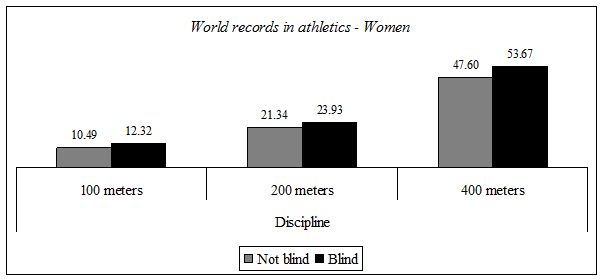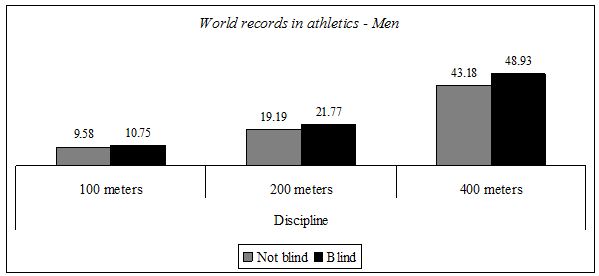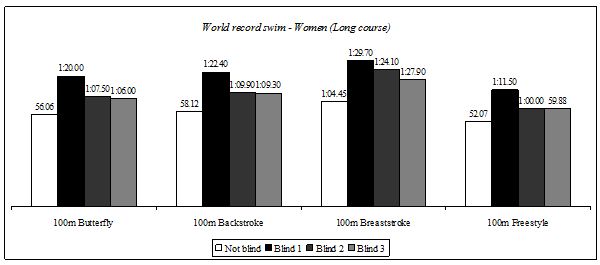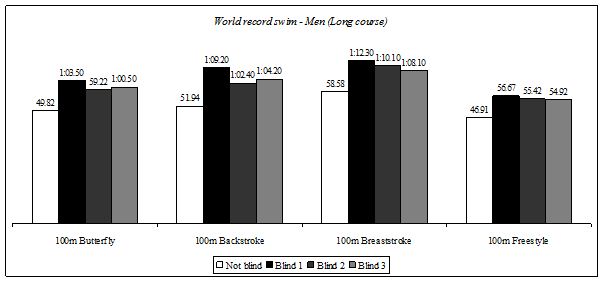
|
|||
|---|---|---|---|
|
|
The visually impaired: involvement in physical activity and sport La discapacidad visual: la participación en la actividad física y el deporte |
|
|
|
MSc in Sport Science Faculty of Sport, University of Porto (Portugal) |
José Luis Lima Constâncio |
|
|
|
Abstract The vision is a sense of fundamental importance in learning of motor skills and movement construction mental of, because the subject needs locate, assessment of space and distance. The aim of this study was to investigate the visually impaired and your involvement in physical activities, especially in the swimming area. Through literature review, we conclude that the lack of vision can affect the performance of athletes and people who are not athletes, may adopt a sedentary lifestyle listening to TV and radio in to their homes. Many studies are focused on participation and encouraging of sport, as this can assist in socialization both verbal and emotional promoting quality of life and physical performance. Despite the negative impact on society and economic field and in the context of physical activity, decreasing the performance of daily activities and high-performance athletes compared to non-blind, the practice of physical activities for the blind has expanded so that today more and more athletes have participated in the Paralympics Games and get great results, despite all the barriers that society imposes on them. Keywords: Blind. Physical activity. Performance.
Resumen El sentido de la visión tiene importancia fundamental en el aprendizaje de las habilidades motoras y la construcción mental del movimiento, ya que el sujeto debe localizar, evaluar el espacio y la distancia en la que se encuentra. El objetivo de este estudio fue investigar a los discapacitados visuales y su participación en actividades físicas, especialmente en la natación. A través de una revisión de la literatura, se concluye que la falta de visión puede afectar al rendimiento de los atletas, y las personas que no son atletas, pueden llevar una vida sedentaria simplemente para escuchar radio y la televisión en sus hogares. Muchos estudios se centran en la participación y el fomento del deporte, ya que esto puede contribuir a la socialización, tanto verbal y emocional promoción de la calidad de vida y el rendimiento físico. A pesar del impacto negativo en la sociedad y el ámbito económico y en el contexto de la actividad física, resultando en una disminución del rendimiento de las actividades diarias y alto rendimiento, en comparación con los atletas no ciegos, la práctica de actividades físicas en este grupo de personas se ha intensificado y los atletas de hoy cada vez más participan en los juegos Paralímpicos y tienen grandes resultados a pesar de todas las barreras que la sociedad les impone.Palabras clave : Ciegos. Actividad física. Rendimiento.
|
|||
|
|
http://www.efdeportes.com/ Revista Digital - Buenos Aires - Año 15 - Nº 146 - Julio de 2010 |
|
|
1 / 1
1. Introduction
The sense of sight is of fundamental importance in modern society, which is organized mainly according to those who have vision and is considered a vehicle of communication in the world. (Tonjum, 1986, Rodney, 2003, Maia, 1996; Trunks, 1999, Mir, 2004, Maia, 1996; Watkinson & Graham, 2005). Aydog et al, 2004; Juodzbaliene & Muckus, 2006 state that the relationship with the environment depends on the processing and integration of afferent information from 3 systems: visual, vestibular and proprioceptive.
The movement depends on the vision to develop, is a type of information involving the location and evaluation of space and distance, it is essential in the construction of mental movement (Tonjum, 1986; Moura e Castro, 2000).
The visual function is the capacity of individuals to give meaning to physical stimuli captured by the eye. "The light energy is captured by the photoreceptor cells of the retina (rods and cones) are transmitted to the occipital area (visual cortex) where it is integrated with information from the other senses". (Ladeira & Queiroz 2002)
The ability to see depends on many factors: the physical and human involvement, the age at which installed the disability, the ability to adapt to the situation, intelligence, personality type, the consciousness of more or less autonomy, education received and the technical support. (Martin & Bueno, 1997)
2. The blind
There is not a standard concept for the visually impaired (Vi), because there are many parameters and settings in different countries (Seixas, 2008). The term Vi can be described as an irreversible situation of reduced visual response due to hereditary causes, congenital or acquired, even after clinical or surgical treatment and glasses. This is because individuals’, even using special optical devices or surgery, the vision remains compromised. (Ramos, 2008)
According to Mir, 2004; Mauerberg-de-Castro, 2005 and Sousa, 2006 the definition of Vi is applied to individuals whose visual impairment remains after trying to fix it without success.
Pereira (1980) states that a person with Vi is "any person who has a great visual loss and, in some cases can be taught to read print using optical aids, and they need special support during their schooling".
According to the World Health Organization Vi may be considered when both eyes with correction, is equal to 0.3, with values equal to 0.1 considered a state of blindness.
Visual impairment can be classified into three different categories:
-
Congenital (if arises from 0 to 1 year of age), the person has a representation of the intellectualized environment (colors, perspective, volume, relief), there is an absence of visual concept.
-
Early (appear between 1 and 3 years old)
-
Acquired (if comes after 3 years of age), has all the visual richness before blindness and have a visual representation of an object or an environment, by analogy. (ACAPO, s / d)
The terminology to define and establish the various degrees of Vi is not homogeneous, many authors base their definitions in visual acuity and visual field. There are several types of vision test that measures one or more visual functions, such as central visual acuity, color perception, opening up the visual field and binocular vision, and the assessment of visual impairment usually done by determining the visual acuity and the opening of the visual field. (Pereira 1980)
According Ladeira & Queiroz (2002) visual acuity is the ability of a person has to perceive and discriminate details of an object at a certain distance and visual field is the "angular distance that the eye can cover the person with the normal 180 ° without moving his head."
An individual may be considered blind when an eye has a corrected visual acuity of 1 / 10 (0.1), and whose visual field is reduced to 20 ° (Masi, 2002).
With a variety of concepts is difficult to clarify the concept of Vi objectively, whether in quantitative or qualitative. Visual perception is determined by a number of environmental factors and personality which in turn influence their assessment qualitative and quantitative. (Ramos, 2008)
Visual impairment has a negative impact on society in general and in the economic domain (Taylor et al, 2007; Meads & Hyde, 2006) in physical activity results in decreased performance of daily activities and high performance when compared to athletes. (West et al., 2002)
3. The blind and physical activity
Physical activity (Pha) practiced by people with disabilities or special needs can be defined as any activity suited to the capabilities of each one with an emphasis on motor development, physical education and all athletic activities according to Silva, 2000.
Many barriers are encountered by the blind in relation to Pha, among which can be highlighted: the lack of understanding and knowledge required by society, fear and anxiety caused by the disability, dependence and exposed its deficiency (Sorensen, SD, and Moura Castro , 1993; Martinez, 1998; Telford and Sawrey, 1988).
One of the consequences of visual impairment is sedentary lifestyle and your integration with the company resulting in poor physical endurance, posture inappropriate release of the tendons decreased nerve causing contractions. (Mir, 2004, Rogow, 1988; Moura e Castro, 1994, Lockette and Keyes, 1994)
The Vi has the same physical needs to use his body like the not blind, because in the absence of Pha, them merely listen the radio or television (Martinez, 1998). In this sense, physical activity adapted promotes the socialization both verbal and emotional and physical, in addition to promoting the quality of life of these people (Maueberg-deCastro, 2005; Tonjum, 1986), and can also promote physical performance as can be seen in the study by Çolak et al. (2004), which we assessed peak torque, flexibility, balance, grip strength and vertical jump in players goalball, where the results showed that the sample obtained superior performance in all parameters.
Mean peak torque values for isokinetic concentric peak torque data of groups.

Motor fitness parameters of goalball player and non-goalball players in class B1, B2 and B3.

According to Craft (1990), Moura and Castro (1994), the fitness levels of individuals with visual impairments are reduced in comparison to not blind. This affirmation can be seen by the world records in athletics and swimming shown below:

Table 1. Created by author, data on record at: www.isba.es / www.iaaf.org

Table 2. Created by author, data on record at: www.isba.es / www.iaaf.org

Table 3. Created by author, data on record at: www.fina.org / www.ibsa.es

Table 4. Created by author, data on record at: www.fina.org / www.ibsa.es
However, Moura e Castro (1993), assumes that this inferiority is related to the removal of the blind with Pha, leaving it unable to connect to the blindness to the inability.
Sherrill (1998) attributes this low physical capacity to sedentary lifestyle and especially the overprotective, since the greater the degree of disability, the greater the protection exercised.
A study about the attitudes of people in the face of physical education and recreation suggests that blind adults perform physical activities as an important part of their recreation and their attitudes are conducive to Pha. (Sherrill, Rainbolt & Ervin, 1984)
For authors Myra Melford and Rose (1995), Novi (1996) and Davis (2007), the individual needs of body movement to explore the environment and become familiar with it, using it to achieve its psychomotor development.
Sport contributes to the improvement of movement, autonomy, so that the visually impaired person have success by yourself, providing a broad knowledge of himself, that together with the experience of successful situations, increase their confidence, self-control, freedom, initiative, body image and communication, contributing to social integration. (Rodrigues, 2002; Silva, 1998; Freitas, 2007)
To Guttmann (1997), Pha for the visually impaired has a greater importance and representativeness than for "normal" people, because in addition to physical and psychological effects common to all regardless of physical condition, it gives a therapeutic and motivational assisting and help in their reintegration into society.
The sighted people are often motivated to practice sports through visual stimuli, while the blind requires internal motivation, thus, the activity should give you pleasure first. (Sherrill, 1998)
Sports for disabled people apply to the person who, with their disability, is able to practice a sport without change. The changes do not take the competitive edge the sport, organized, institutionalized and regulated have. (Silva, 1991)
In sport for people with disabilities there are several common tests to sports in general, however, adapted to this population, with a smaller more limited number of specific evidence in some areas of deficiency. (Pereira, 1998)
4. Adapted swimming
The adapted sport consists of sports experiences that have been modified or specially designed to go against the special needs of a group of individuals for the physical and psychological rehabilitation, which may adopt the characteristics of integration (where people with disabilities interact with non-disabled people) or segregated features (which only include people with disabilities). (Dias, 2007, Winnick, 1990, Silva, 2008)
The practice of motor activities for people with disabilities - such as empowerment, rehabilitation and social interaction - is in one of the main tools for the development of individual and collective potential of this segment of the population. It is noticeable the gains as a result of participation in leisure activities and sports, whether in the sensorimotor and / or psychosocial. (Abrantes et al, 2006)
The water activities contribute to improving the notion of the body and the segments that compose it, makes it easier to breath control, control of head movement, relaxation, increased strength and muscular endurance, flexibility, mobility, self-esteem, confidence and facilitates social inclusion. (Rodrigues, 1997; Souza, 1994)
Swimming in this way has been of great importance to the overall development of people with visual impairments, it can be practiced at any age and physical condition, bringing benefits that directly influence their daily activities, encouraging and facilitating the social interaction of people (Abrantes et al, 2006).
Therefore, the use of swimming as motor activity for people with visual impairment is highly recommended, as this is a sport that allows for independence and autonomy of its practitioners, and provide many benefits that are linked to safety and quality of student life / apprentice. (Abrantes et al, 2006)
Swimming is a great sport to make of inclusion of blind and visually impaired in the sport, it has features such as rules, forms of learning, training, competition and other factors that favor the inclusion of disabled people in the environment of physical activity focused on health, and also allows for its format, the routing for the competitive sports environment. (Abrantes et al, 2006)
The practice of swimming for people with blindness and visual impairment was initially restricted to medicinal use, but with the popularization and dissemination of sports for people with disabilities, swimming has also been practiced as a competition. (Abrantes et al, 2006)
5. Final remarks
The absence of the sense of vision can affect motor skills of the individual, however this does not prevent the Vi to be physically active. The practice of sports activity can cause a sense of independence and autonomy of this class of disabled generating multiple benefits including: physiological, sociological and psychological. Although existing research on the issue of visual impairment are still necessary studies related to Vi and physical activity or studies linking certain sports activities and / or training of that class of athletes. The athlete Vi has the same capabilities and limitations as any other sportsman, so you must exploit it to maximum performance and satisfaction and achieve even better results.
References
-
ACAPO. (s/d). Constult. 07 de Fevereiro de 2010, disponível em www.acapo.pt
-
Abrantes, G. M., Luz, L. M. R., Barreto, M. M. (2006) Natação paraolímpica: manual de orientação para professores de educação física – Brasília: Comitê Paraolímpico Brasileiro, pp 48 il.
-
Aydog, S.T., Aydog, E., Çakci, A., & Doral, M.N. (2004). Reproductibility of postural stability scores in blind athletes. Isokinetics and Exercise Science, 12(4), 229-232.
-
Baus, S. (1999). Commentary: Psychological aspects of visual impairment. British Journal of Visual Impariment, 17(1), 41-44.
-
Bautista. (Ed.) Necessidades Educativas Especiais (pp 58). Lisboa: Dinalivro.
-
Çolak, T., Bamaç, B., Aydin, M., Meriç, B., Özbek, A. (2004) Physical fitness level of blind and visually impaired goalball team players. Isokinetics and Exercise Science, 12(4), 247-252.
-
Craft, D. H. (1990). Sensory impairments. In J. P. Winnick (Ed.), Adapted physical education and Sport (pp. 209-228). Champaign: Human Kinetics Books.
-
Freitas, S, (2007). A percepção da Imagem Corporal no Deficiente Visual. Estudo comparativo entre praticantes de Futsal para cegos, de Goalball e não praticantes, com idades compreendidas entre os 20 e os 58 anos. Dissertação de de Licenciatura apresentada à Faculdade de Desporto da Universidade do Porto.
-
Guttmann, L. (1997). Antologia Desportiva, Desporto para Deficientes Físicos, Lisboa.
-
INDESP. (1998) Desporto Adaptado no Brasil: origem, institucionalização e atualidade. Brasília, pp. 11-140.
-
Juodzbaliene, V., Muckus, K. (2006). The influence of degree of visual impairment on psychomotor reaction and equilibrium maintenance of adolescents. Medicina (Kaunas), 42(1), 49-56.
-
Ladeira, F., Queiroz, S. (2002). Compreender a baixa visão. Lisboa: Ministério da Educação.
-
Lockette, K. F.; Keys, A.M. (1994). Conditioning with other physical disabilities In: Physucal and Health Caracteristics in Conditioning with Physical Disabilities. Human Kinetics, USA.
-
Maia, M. (1996). Os cegos e a cultura. Integrar, 11, 26-29.
-
Martin, M. B., & Bueno, S.T. (1997). Necessidades Educativas Especiais. In R. Martínez, J.M.A. (1998). Motricidad, Autoconcepto e Integracíon de Niños Ciegos. Editorial Universidad de Granada, España.
-
Masi, I. D. (2002). Programa Nacional de apoio à Educação de deficientes visuais (Secretaria de Educação Especial Ed.). Brasil: Ministério da Educação.
-
Maueberg-deCastro, E. (2005). Atividade Física Adaptada. São Paulo: Tecmedd Editora.
-
Meads, C., Hyde, C. (2006); How much is the cost of visual impairment: caveat emptor. Pharmacoeconomics, 24(2), 207-209; discussion 210.
-
Mir, M. (2004). Discapacidad visual. In M. C. Jórdan (Ed), Atletismo adaptado para personas ciegas y deficientes visuales (pp. 15-27). Barcelona: Editorial Paidotribo.
-
Moura e Castro, J.A. (1993). Estudo da influência da capacidade de resistência aeróbica na orientação e mobilidade do cego. Espaço 1:2, PP. 11-21, Portugal.
-
Moura e Castro, J. (1994). Estudo da influência da capacidade de resistência aeróbia na orientação e mobilidade do cego. Lisboa: Secretaria Nacional de Reabilitação.
-
Moura e Castro, J. (2000). Contributo para o estudo do treino do atletismo para deficientes visuais (corridas e saltos) – experiência baseada em situações simulads como normo-visuais. Horizonte, XVI(91), 17-21.
-
Pereira, C. (1998). Estudo do tempo de reação simples e de escolha em indivíduos com deficiência visual e não praticantes de atividades desportivas. Dissertação de mestrado apresentada a Faculdade de Desporto da Universidade do Porto.
-
Pereira, L. (1980). O conceito de deficiência visual. Ludens, 4(4).
-
Ramos, D. G. E. F. (2008). A inclusão na aula de Educação Física: a perspectiva de alunos portadores de deficiência visual. Estudo realizado com alunos entre os 12 e os 19 anos. Dissertação apresentada às provas de Mestrado em Ciências do Desporto na área de Actividade Física Adaptada. Porto: Faculdade de Desporto da Universidade do Porto.
-
Rodney, P. (2003). The psychological aspect of visual impairment as central understanding in the development if inclusion. Britsh Journal of Visual Impairment, 21(1), 19-24.
-
Rodrigues, C. (1997). A natação como terapia na paralisia cerebral. Faculdade de Ciências do Deporto e Educação Física, Porto.
-
Rodrigues, C. (2002). Goalball: Estudo sobre o estado de Conhecimento da modalidade e avaliação desportivo-motora dos atletas. Dissertação de mestrado apresentada à Faculdade de Desporto da Universidade do Porto.
-
Rogow, S. M. (1988). Helping the visually impaired child. New York: Teachers College Préss.
-
Seixas, A. (2008). A proprioceptividade em indivíduos cegos e normovisuais praticantes e não praticantes de atividade física. Porto: A. Seixas. Dissertação de Mestrado apresentada à Faculdade de Desporto da Universidade do Porto.
-
Sherril, C., Rainbolt, W., Ervin, S. (1984). Attitudes of blind persons toward physical education and recreation. Adapted Physical Activity Quarterly, 1, 3-11.
-
Sherrill, C. (1998). Blindness and Visual Impairments In; Adapted Phsysical Activity, Recreation and Sport. WCB/Mc Graw-Hill, USA.
-
Silva, M. (1991). Desporto para deficientes. Corolário de uma evolução conceptual. Dissertação apresentada às provas de Aptidão Pedagógica e Capacidade Científica da Faculdade de Desporto da Universidade do Porto.
-
Silva, M. (2008). O desporto adaptado no conselho de Santa Maria da Feira – Estudo de caso do Projeto da Natação Adaptada da Feira Viva. Porto: M. Silva Dissertação de Licenciatura apresentada à Faculdade de Desporto da Universidade do Porto.
-
Silva, M. A. (2000). Reabilitação, Educação Especial e Atividade Física. In: A recreação e Lazer da População com Necessidades Especiais. Actas do Seminário 21, 22/jan. Faculdade de Ciências do Deporto e Educação Física, Porto.
-
Silva, S. (1998). Influência do desporto no autoconceito de indivíduos paraplégicos. Dissertação de mestrado apresentada a Faculdade de Desporto da Universidade do Porto.
-
Sorensen, M. (1999). Physical Activity for Individuals with Disabilities: Sensory Impairments and Psychosocial Problems. The Norwegian University for Sport and Physical Education, Oslo.
-
Sousa, M. P. S. (2006). A aplicaçãoo dasd artes plásticas para deficientes visuais na terceira idade. São Luís: EDUFMA.
-
Souza, P. (1994). O esporte na Paraplegia e Tetraplegia. Editora Guanabara Koogan S.A.
-
Tayllor, H. R., Pezzullo, M. L., Nesbitt, S. J., Keeffe, J. E. (2007). Costs of interventions for visual impairment. Am J Ophthalmol, 143(4), 561-565.
-
Telford, C.W.; Sawrey, J.M. (1988). O índivíduo exepcional. Ed. Guanabara, Rio de Janeiro.
-
Tonjum, A. M. (1986). Sports for the blind. In A. Vermeer (Ed.), Sports for disabled (pp. 79-81). Arnhem: Uitgeverij de Vrieseborch.
-
Tsutsumi, O., Cruz, V. S., Chiarello, B., Junior, D. B., Alouche, S. R. (2004) Os Benefícios da Natação Adaptada em Indivíduos com Lesões Neurológicas. REVISTA NEUROCIÊNCIAS V12 N2 - ABR/JUN.
-
Watkinson, S., Graham, S. (2005). Visual impairment in children. Nurs Stand, 19(51), 58-65; quiz 66.
-
West, S. K., Rubin, G. S., Broman, A.T., Munoz, B., Bandeen-Roche, K., Turano, K. (2002). How does visual impairment affect performance on tasks of everyday life? The SEE Project. Salisbury Eye Evaluation. Arch Ophthalmol, 120(6), 774-780.
Another articles in English
 |

Búsqueda personalizada
|
|---|---|
|
EFDeportes.com, Revista Digital. Buenos Aires, Año 15, N° 146, Julio de 2010 |
|